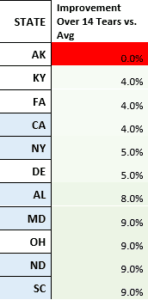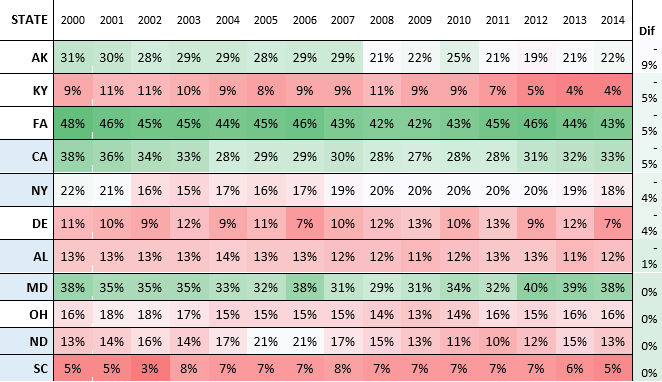Widely regarded by child welfare professionals as the best placement option for foster children, kinship care has been on the rise in the United States. Collectively, child welfare agencies have been pushing for more kinship placements as reports show that outcomes improve for children placed into the care of relatives. These kinship care trends are signs that our child welfare system is working. From a legislative standpoint, however, the major breakthrough in kinship care came in the form of the Fostering Connections for Success and Increasing Adoptions Act (FCSIA, also known as the Fostering Connections Act).
Laying the Groundwork for Kinship Care Trends
Passed in 2008, this bill paved the way for kinship care throughout the nation. Although “kinship care” as a concept was introduced to the US child welfare system as early as 1978 (way it was vs way it is link), it wasn’t until 1990s that it was regulated and supported by federal funds, becoming endorsed by the federal government as a specific program within foster care. At that time, more than 75% of the children in kinship care were in private or unlicensed homes.
With the introduction of the Fostering Connections Act, kinship homes were formally integrated into the child welfare system, and relative caregivers became integrated into the term “foster parents.” By turning kinship homes into state-approved entities, kinship parents became eligible for Title IV-E and IV-B federal funding as enumerated in the FCSIA. From here, the growth of services available to relative caregivers continued to expand, giving them access to a number of support programs including but not limited to:
- Temporary Assistance to Needy Families (TANF)
- Food stamps
- Supplemental Security Income (SSI)
- A variety of supplemental income sources
These services, more closely examined in the article “Kinship Care in the United States: An Overview,” are crucial in easing the burden on relative caregivers and improving the nation’s kinship care trends. These relatives are often grandparents or aunts and uncles with families and pre-existing responsibilities that make taking on an additional child a dire challenge. Grandparents in particular face unique struggles as foster parents – as we’ve reported before (Kinship care cost link) around three-quarters of grandparent kinship caregivers earn roughly $12,000 or less a year, making the expenses of unexpected childcare extremely burdensome. Since 2000, the United States has increased the number of kinship placements from 25% of the total foster care population to 29%. With the child welfare system leaning on kinship parents more and more every year, supports like these are crucial to the success of what has proven to be one of the most effective means of providing positive outcomes for children in the child welfare system.
It’s no secret that it is in part because of these systems that the United States is experiencing an overall growth in kinship care trends. For individual states, however, the picture blurs somewhat. As each state creates its own rules and guidelines for its child welfare system, each becomes distinct and separate. These distinctions often mean that certain states, as they implement new initiatives and programs, emerge as leaders in kinship care trends. Below, we’ll examine some of the states that seem to have made the most progress in kinship care.
Leaders in Kinship Care Trends
So, which states are leading the way in kinship care placements?
Almost unsurprisingly, the states with the highest percentage of kinship placements for the 2014 year are also those that were already supporting them before the Fostering Connections Act came into play in 2008. The top five states for percentage of kinship placements are:
1) Hawaii – 47%
2) Arizona – 46%
3) Florida – 43%
4) Montana – 41%
5) Maryland – 38%
Each of these states also bears the distinction of surpassing the national average (29%) massively, showing that they are truly the best states when it comes to accomplishing the goal of increased kinship placements.
For reference, here are the rankings and percentages for these states in the year 2000:
1) Florida – 48%
2) Hawaii – 39%
3) Maryland – 38%
4) Montana – 32%
5) Arizona – 25%
At no point over the past four years have any of these states dropped below 25%, meaning they have always had anywhere from one quarter to one half of all placements as kinship care placements. Although some of the states are at lower levels of kinship placements than 2000, overall, they represent the very best in kinship care placements.
Most Improved In Kinship Care Trends
Being the best, however, is only a part of the story. With data that spans 14 years, we can also investigate those states that made the most progress in kinship care placements. The states that most increased these placement numbers are:
1) New Jersey – From 7% to 36% (+29%)
2) Maine – From 4% to 31% (+27%)
3) Iowa – From 1% to 28% (+27%)
4) Louisiana – From 12% to 33% (+23%)
5) Vermont – From 10% to 33% (+23%)
Each of these states has a unique picture painted as we trace the statistics surrounding their increase in kinship care placements. For the chart below, note the fading of each cell from red to green which represents the transition from low to high percentage of kinship placements. Most states see a big change right around the middle – between the years 2005 and 2008.
The Fostering Connections Act was passed in 2008 and was being prepared in the legislature between that same span of years. In this way, the chart shows the efficacy of that act; even these low performing states began to increase their kinship placements. In fact, of all 50 states, only 7 states in 2014 showed a decrease in the amount of kinship placements compared with their year 2000 numbers. Only 4 showed no improvement.

A chart showing states’ 14 year improvement in kinship care trends compared with the nation’s improvement over the same span.
By this standard, most states are doing a great job – even those that appear to be lagging behind have made improvements. When comparing their improvements to increases in the average number of kinship placements across the country, all but one state ended 2014 closer to the national average than they were in 2000. In the image to the left, those same states are ranked by their improvement versus the national average. For example, in 2014 South Carolina was 9% closer to the national average than it was in 2000.
Although lagging states and low numbers may make it seem as though the U.S. is making relatively small gains in the kinship care field as a whole, it must be understood that the processes that turn kinship care from an idea into a fully-supported program require time.
Building Momentum with Kinship Care Trends
As early as 1991, New Jersey specified that child welfare agency MUST make best efforts to place a child with a relative, including arranging additional services as necessary, but it wasn’t until the Fostering Connections Act that such services were detailed and the means of access determined. As the discussions around kinship care spread through the legislature, Foster and Adoptive Family Services (FAFS) took an active role in determining how kinship care would be implemented in New Jersey.
As of February 6, 2006, standards and definitions surrounding kinship care were issued in the Manual of Requirements for Resource Family Parents, the result of a meeting in which FAFS participated. One result of that meeting was that the state would allow the use of attics or basements as bedrooms solely for resource parents. This is important for kinship parents in particular as they are often asked to take on a sudden placement and may not have an extra bedroom. FAFS understood that the law required greater flexibility if it were going to accommodate the needs of relative caregivers.
The constant progress towards a greater percentage of kinship placements continues, and if states are going to keep up with the trends, they will need to investigate positive examples from the current kinship leaders like Hawaii, Florida and New Jersey.




where is this data drawn from? Please provide a citation.